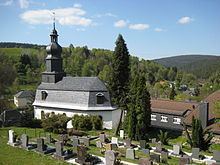Elevation 580 m (1,900 ft) Area 19.36 km² Population 1,681 (31 Dec 2008) Dialling code 036701 | Municipal assoc. Lichtetal am Rennsteig Time zone CET/CEST (UTC+1/+2) Local time Friday 7:10 AM Postal code 98739 | |
 | ||
Weather 7°C, Wind SW at 21 km/h, 62% Humidity | ||
Lichte is a municipality in the district of Saalfeld-Rudolstadt in Thuringia, Germany, close to the Thuringian Rennsteig.
Contents
- Map of Lichte Germany
- Geography
- History
- Heraldry
- Politics
- Municipal council
- Places of interest
- Annual events
- Economy and infrastructure
- Local enterprises
- Notable people associated with Lichte
- References
Map of Lichte, Germany
Geography
Lichte is located between the towns of Saalfeld (to the north), Oberhof / Ilmenau (northwest) and Sonneberg / Coburg (south) at an altitude of 600 m (NHN), in the centre of the Thuringian Highlands / Thuringian Forest Nature Park. Distinctive sign of Lichte is the railway viaduct established in 1909 (see picture right).
It is a typical Thuringian Forest village, reaching far into the valleys of the Lichte River and of its tributary the Piesau. Both of these feed one of the biggest Thuringian drinking water reservoirs, Leibis-Lichte, with the Deesbach Forebay close to the northern end of the village (in Geiersthal). The Lichte River is also one of the sources of the Schwarza River.
The mountain rivers and streams in the area of the Lichte valley have been known for centuries for deposits of placer gold and are considered the most significant sources of gold in Germany.
Around the steep-sided valleys of the Lichte and Piesau, the height difference between hilltops and valley bottoms is often as much as 200 m, which is large for hills of this size.
History
Already in 1764 there was porcelain manufacturing in Lichte (Wallendorf). The Wallendorf porcelain manufacture is one of the oldest in Europe. It quickly achieved a growing customer base beyond the then borders of the country. Thus as early as 1822, Johann Heinrich Leder established in Lichte another porcelain company, today’s Lichte porcelain (GmbH). The new company competed with Wallendorf. However, it was able to rapidly find and keep markets of its own, although the two World Wars followed by East German trade restrictions caused setbacks.
Until 1920, the Lichte River was the dividing line between the district of Saalfeld in Sachsen-Meiningen in the east and the rural district of Königsee in Schwarzburg-Rudolstadt in the west. In 1952 the municipality was formed by combining several mountain villages: from south to north, Lichte, Wallendorf, Geiersthal and Bock and Teich. From 1922 to 1952, the municipality belonged to the rural district of Saalfeld, from 1952 to 1994 to the district of Neuhaus, and since then has been in the district of Saalfeld-Rudolstadt.
During World War II, Polish forced labourers worked in Wallendorf; four graves in the cemetery there recall this time. A memorial tablet at the Lichte cemetery commemorates two victims of the death march of inmates from the Buchenwald concentration camp in April 1945 who were found in the depths below the rail viaduct.
Heraldry
The coat of arms of Lichte, a silver candlestick with gold flame and beams of light between 4 silver maple leaves on a field of green, was approved on July 15, 1995. The candlestick is taken from an ancient seal. It thus perpetuates a traditional symbol of the locality and also represents the centuries-long heritage of porcelain manufacturing that typifies Lichte and the region. The maple leaves symbolize the four sections of the municipality using a tree that is typical of the area. They and the green field also symbolize Lichte's location in the forested Thuringian Highland, while the shape at the base of the shield represents its location in valleys.
Politics
The local government of Lichte and of the municipal association of Lichtetal am Rennsteig (Lichte Valley on the Rennsteig), which consists of the municipalities of Lichte, Piesau, Reichmannsdorf, and Schmiedefeld (Lichtetal), are located in the Wallendorf section.
Municipal council
The municipal council of Lichte consists of 12 councillors including the mayor, who serves in an honorary capacity.
Places of interest
Annual events
Economy and infrastructure
The local economy, typically for the Thuringian Highland, is based on tourism, glass and porcelain manufacturing, and woodworking. There has been porcelain manufacturing in Lichte since at least 1764; Wallendorfer Porzellan (Wallendorf Porcelain) is one of the oldest such companies in Europe.
